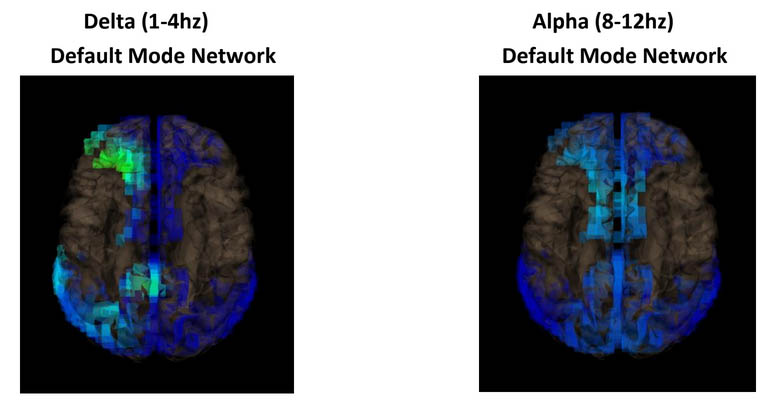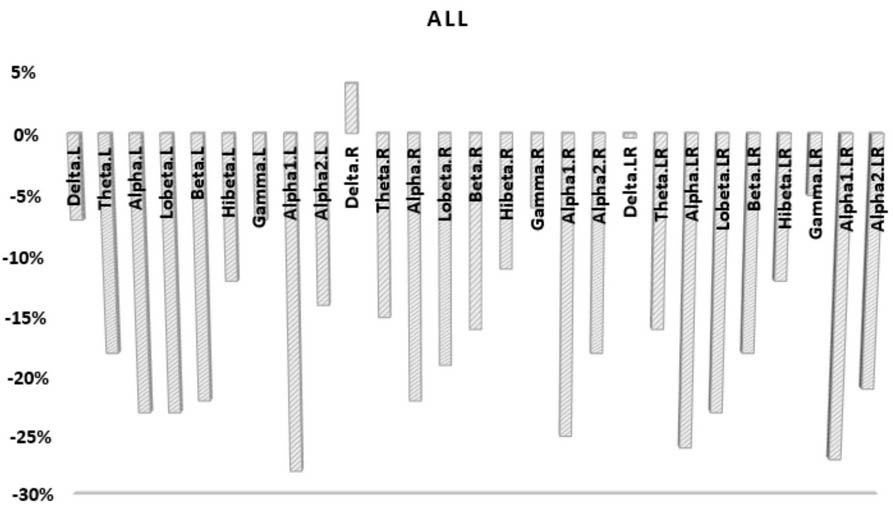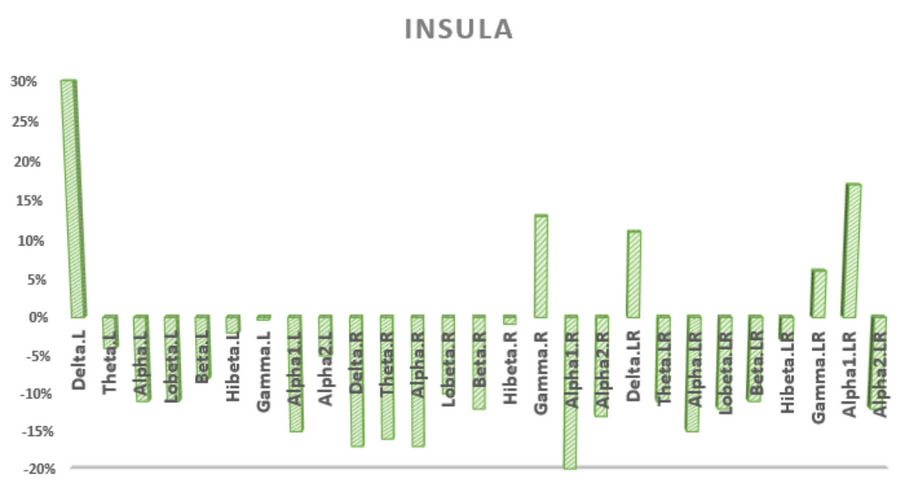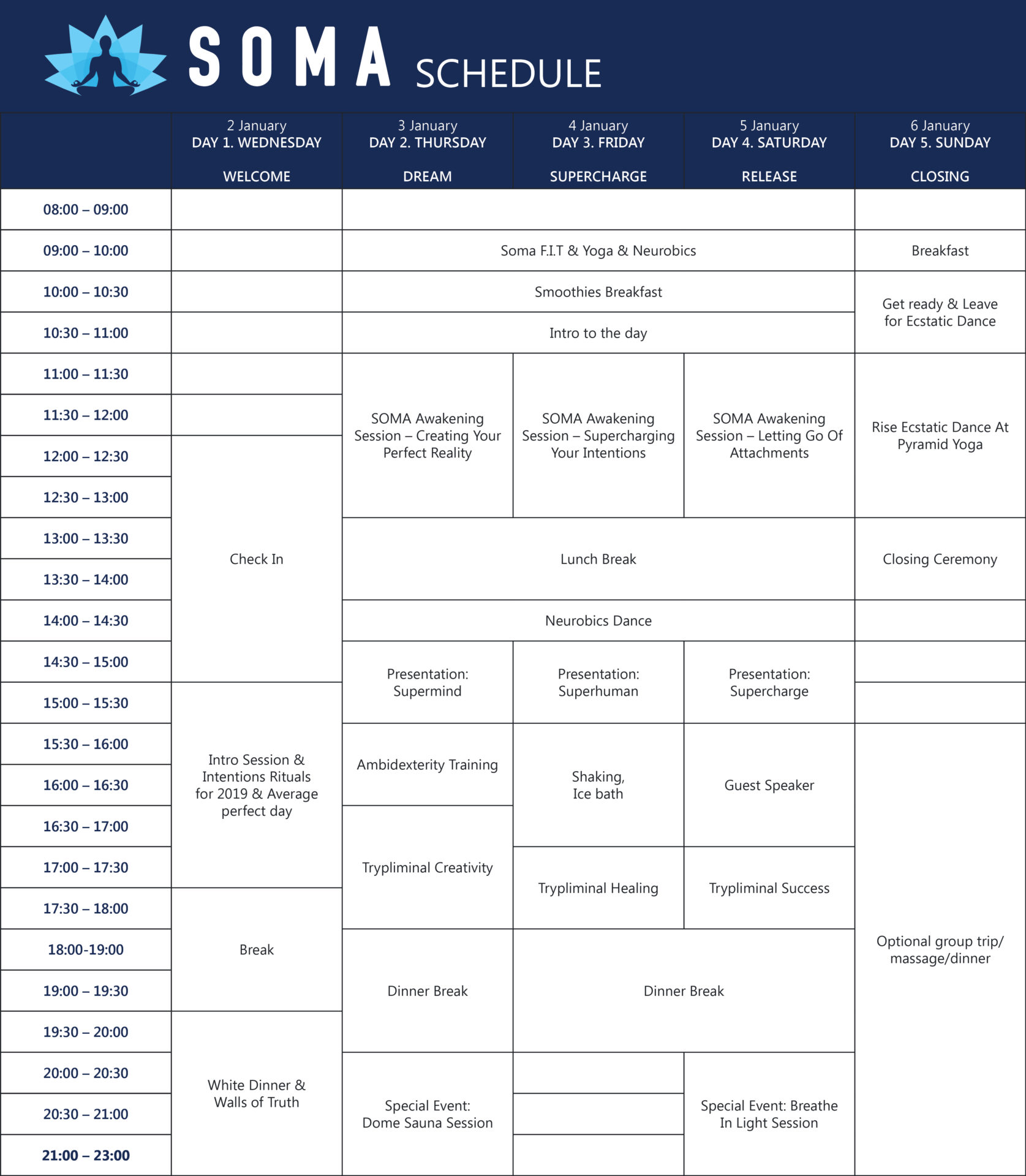By: Jeff Tarrant, Ph.D., BCN – NeuroMeditation Institute
This series of case studies was designed to determine if participating in specific SOMA breathing techniques can result in significant altered states of consciousness. The results were measured by subjective questionnaires and quantitative EEG analyses, allowing us to compare the results to previously published research with traditional psychedelics.
Methods
Subjects
All Subjects were female, ranging in age from 23 to 48. 66% identified as White, and 33% identified as Hispanic/Latino of Spanish origin. All subjects had experience with yoga, seated meditation, and breathwork/Pranayama, all having engaged in these practices at least 1-2 times per week or more.
Intervention
SOMA breathwork
SOMA breathwork is a complete system of breathing techniques that combines ancient practices of Pranayama with modern science. The primary breathing experiences in this system consist of alternating between several minutes of rhythmic/cyclic breathing with breath retention. The entire practice is guided with a music soundtrack that includes verbal guidance as well as a rhythmic drum pattern to coordinate the breath. The rhythmic breathing portion of the practice involves inhaling and exhaling in a timed ratio with no pause at the top or bottom of the breath. In addition, participants are encouraged to pull up from the Perineum during inhalation and relax during the exhalation. The breath retention portion of the practice involves exhalation all the air out of the lungs and then holding the breath as long as possible. When it is necessary to take a breath, participants are instructed to take a quick, short sip of air, exhale completely and hold the breath again. This process is repeated twice followed by a deep inhalation and a breath retention with full lungs. In the current study, participants were guided in a 23-minute practice which included two rounds of the pattern described above.
Procedure
Subjects were provided with a detailed explanation of the research process and the techniques involved in the SOMA breath meditation. After questions and concerns were addressed, subjects completed demographic forms and the Brunel Mood Scale. They were then fitted with a 19-channel electrocap. Impedence levels were monitored and kept below 10 kOhms. Baseline EEG recordings were obtained in an eyes closed, seated position using a BrainMaster Discovery EEG system. Following the baseline data collection, subjects wore ear covering headphones to listen to the guided breath practice. EEG was recorded continuously during the breath meditation. Immediately following the meditation, a post-meditation EEG was recorded and the subject was asked to complete a second Brunel Mood Scale as well as the Altered States of Consciousness questionnaire.
The primary concern of this study was to determine if the SOMA breathing experience resulted in the subjective experience of altered states of consciousness and if the brain demonstrated patterns similar to those observed during the use of traditional psychedelics (e.g., Psilocybin, LSD, etc.).
As a pilot, we initially examined a single subject. After transforming the Pre-Soma EEG into a reference database, this data was compared to the EEG data from the Post-Soma EEG. These analyses provided z-scores of change for all band waves (e.g., alpha, theta, beta, etc.) in 84 regions of interest. Based on previous research (Collura, 2017), any z-scores greater than .8 was considered significant. Taking a conservative approach, we only examined z-scores greater than 1.0 in this study.
The 3D brain images displayed below shows changes in the brain after the Soma breath meditation. Cooler colors (blues) indicate that the activity measured decreased activity whereas brighter colors (yellow, orange, red) indicate that activity has increased. Dark blue shading indicates areas that decreased by at least 1.0 z-scores. Red and Gray areas indicate areas that increased by at least 1.0 z-scores. Green areas did not change significantly.
Subject 1:
These images allow us to examine overall patterns. When examined this way, we notice that the delta, theta, and alpha brainwaves all decreased significantly and globally.
When we consider the faster brainwaves (beta-gamma), we notice a significant decrease of activity in the right frontal regions (beta, hi beta) while gamma did not show any significant changes.
Overall, these preliminary results suggested that the Soma breathwork practice has a significant quieting of overall EEG activity. To examine these findings in a bit more detail, we used a special analysis technique to examine brainwave patterns below the surface of the brain. sLORETA (Standardized low resolution brain electromagnetic tomography), allows us to extrapolate from the surface to deeper brain regions. The specific regions of interest we examined included the Default Mode Network (DMN). The DMN is an important set of structures in the brain that work together to create our identity-how we see ourselves and talk to ourselves about ourselves. This region has gained a lot of attention recently due to its functioning in relation to mental health. Specifically, the DMN tends to be overactivated with mental health concerns and quiets during the therapeutic use of psychedelics and certain forms of meditation. Changes in the DMN during the Soma meditation are displayed below:
We specifically looked at Delta and Alpha activity in the DMN as decreases in these two EEG bands are most associated with mystical experiences and improvements in mental health in research with psychedelic medicines.
Clearly, the initial subject demonstrated brain patterns consistent with a psychedelic experience. The next task was to determine if this pattern was consistent among participants and if their subjective experience contained elements of an altered state. We expanded the subject pool to 8 subjects. Two subjects were eliminated from the analysis due to participant compliance and poor EEG readings. The final data set consisted of 6 participants using the same research protocol described above.
After averaging the brainwave activity of the 6 subjects, we compared pre-post SOMA meditation data across all EEG bands, determining the overall percent change observed.
This chart shows that nearly all brainwaves, in both hemispheres (L vs. R), averaging all of the sLORETA voxels, decreased significantly following the SOMA meditation. In some cases, decreasing by nearly 30%. It is important to note that the brainwaves showing the greatest change were the Alpha bands, particularly alpha1 (8-10 hz).
As noted earlier in this report, our primary concern is with the Default Mode Network, as this set of structures is critically important in altered states of consciousness, meditation, and mental health. When we specifically examine changes in the DMN, we see similar patterns.
All brainwaves, in both hemispheres, decreased in the DMN following the SOMA meditation. Again, similar to the overall brain patterns observed, the strongest changes related to decreases in Alpha, in some instances, decreasing by nearly 30%.
The hub of the DMN is a brain structure called the Posterior Cingulate Cortex (PCC). Because of its role in orchestrating complex cognitive processes related to “the self,” it has become the most examined brain structure in relation to psychedelics. When we apply the same pre-post comparison to the PCC, we again, see familiar changes, including a significant (30%) decrease in Alpha1 in the right hemisphere. Interestingly, we also see an increase of theta (4-8) activity in this same region. This is a slow brainwave often associated with memory, creativity, and the subconscious. It is the brainwave that is most often activated during a hypnotic state and can be connected to the brain being in a receptive state. The possibility that the SOMA breathwork process shares similarities with psychedelics and hypnosis will be described in more detail in the discussion section of this report.
Because it was noted that many of the participants reported positive mood states occurring as a result of the SOMA meditation, we also examined changes in the Insula. This is a brain region involved in the experiencing of a variety of feeling states including pain, love, craving, addiction, and pleasure. It has also been suggested that the Insula plays a central role in our present-moment awareness.
Clearly there was not as much decreased activity in the Insula as the other examined regions. Importantly, there was also an increase of gamma activity in the Insula. Gamma is the fastest brainwave we tend to measure and is typically seen as reflecting brain activation as gamma activity shows the strongest and most consistent relationship to glucose metabolism (Oakes et al., 2004).
Next, we wanted to explore the subjective experience of the subjects. As noted above, all subjects completed Pre-Post Brunel Mood Scales. This allowed us to examine any changes in how the SOMA meditation changed feeling states.
Brunel Mood Scale
The Brunel Mood Scale (Soos et al., 2007) consists of 32 mood descriptors that are categorized into 8 unipolar dimensions: anger, tension, depression, vigor, fatigue, confusion, happiness, calmness. Using a response frame of “how do you feel right now?” subjects indicated the extent of their experience of the mood descriptors on a 5-point scale (0= not at all, 1= a little, 2= moderately, 3= quite a bit, 4= extremely). The graph below shows the average changes, reported by the 6 subjects.
Subject responses indicated significant decreases in feelings of tension, fatigue, and confusion, and significant increases in happiness and calmness. It should be noted that amount of change observed was influenced by a floor effect (anger) and a ceiling effect (happy). Essentially, if subjects tend to score very low or very high at baseline testing, there was not much room for them to change on the scale. When we examine Brunel mood changes by subject, there is some interesting variability in responses.
Subject 3, showed a 100% decrease on the depression scale, while the other subjects showed no change. When you examine the raw data, it is clear that subject 3 is the only subject that endorsed any feelings of depression before the intervention. After the intervention, those feelings were reported as non-existent, resulting in a 100% change. Subject 6 showed a dramatic increase in Fatigue, while all other subjects showed a large decrease. Upon discussion with the subject, it was clear that she was sleep-deprived before beginning the session. She become increasingly relaxed, which led her to feel tired. It is also interesting to observe the dramatic changes for subject 5 on the Happy and Calmness scales. This person reported feelings of bliss after the experience moreso than other subjects. These results point to the idea that there are, perhaps, some common and expected responses to the Soma meditation as well as some important individual differences. This pattern can also be observed on subjects responses to the Altered States of Consciousness questionnaire.
Altered States of Consciousness Scale
The Altered States of Consciousness Scale (OAV) has been in use for nearly 30 years and applied in a broad range of settings to examine a person’s experience during non-ordinary states (Studerus, et al., 2010). The scale contains 66 items, organized into 11 scales, measuring experiences such as, “Experience of Unity,” and “Disembodiment.” The original scale utilized a visual analogue scale for each item that measured 100 millimeters. This was replaced in the current study with a 0-10 Likert Scale.
This scale was only adminstered after the Soma meditation, as it would not make sense to assess altered states without an intervention. The scale below shows the subject’s raw scores for each of the ASC scale.
The main purpose in examining all subjects in this manner is to observe trends and individual differences. Clearly, all subjects reported low levels on “Impaired Control and Cognition” as well as on the “Anxiety” scale. Certain scales showed an almost uniform pattern of responses, such as “Experience of Unity,” and “Spiritual Experience.” Other scales showed a fair amount of variability, such as “Complex Imagery,” and “Audio-Visual Synesthesia.”
To assess whether these scores were meaningfully related to a psychedelic experience, we compared the scores to data from previously published research with psilocybin mushrooms and MDMA. Total scores for each subject, for each scale were transformed into a total percentage (0-100) providing a means to compare data from previous studies with data from the current study.
These results, suggest that the Soma breathwork meditation shows many consistencies with other psychedelic medicines. In fact, 3 of the scores for Soma were higher than the comparison medicines, including “Experience of Unity,” “Spiritual Experience,” and Changed Meaning.” Not surprisingly, Soma scored lower than Psilocybin on “Elementary” and “Complex” Imagery. It also scored lower on “Bliss.”
Conclusions:
The results from this study suggest that the Soma breathwork meditation can produce experiences similar to those of traditional psychedelics. The results of the ASC questionnaire demonstrate this quite clearly, showing the overall trend of all subjects to report “experience of unity” and “spiritual experience” at a level higher than previously published research with Psilocybin and MDMA. Importantly, the brainwave changes that were observed in this study also mimic research with traditional psychedelics, namely a decrease of power across all EEG bands, with an emphasis on decreased alpha in the Posterior Cingulate Cortex (PCC). The PCC is the hub of the Default Mode Network which is largely responsible for creating our “sense of self.” One of the reasons that traditional psychedelics may be effective in treating a wide range of mental health concerns, is their ability to disrupt this system. When the mental processes that create an identity are “off line,” it provides an opportunity for something new to happen, to reinterpret aspects of previous traumas, or begin to program new potentials into the subconscious mind. In this way, the therapeutic mechanism of psychedelics may share something in common with hypnosis.
Hypnosis is generally thought to exert its effect by shifting “normal, waking consciousness” into a state that is more receptive, a state that is not encumbered by rigid ideas around identity and possibility. While there may be a variety of brainwave patterns associated with the hypnotic state, one of the most common is an increase of theta activity. Interestingly, this was observed in the PCC. In fact, it was the only brainwave pattern in either hemisphere of the PCC to increase in response to the Soma meditation practice.
In addition to the above effects, it also appears that the Soma meditation practice has a positive effect on mood states. Overall, subjects in this study reported a significant decrease of negative mood states such as tension and confusion, and a significant increase in positive mood states such as calmness and happy. Again, when we examined brain regions often involved in emotional processing (Insula), we saw a pattern of increased gamma in this region, particularly in the right hemisphere. This is important because right Insula activation often corresponds to the embodiment of a feeling state. Rather than just thinking about an emotion, they are feeling it in the body.
The overall results of this pilot were very positive and suggest that Soma breathwork may have the capacity to induce states similar to those observed with traditional psychedelics as well as some possible hypnotic processes and mood enhancing effects. This further suggests that this type of breathwork practice may have therapeutic potential, particularly if used intentionally to process past traumas and/or to embed new beliefs and behaviors into the subconscious mind.
There was one result from this study that was a bit unexpected. While subjects reported experiencing elements of bliss, these scores were significantly lower than what has been reported with other psychedelics. One potential reason these scores were not higher in this sample is due to the fact that the subjects had never done this exercise before and it was a shortened version of the typical 1-hour practice.
Future studies should explore these patterns during a 1-hour Soma breathwork experience. In addition, it may be useful to specifically examine subjects who have more experience with this form of breathwork. Further, it may be valuable to examine individual subjects that have very strong responses to the practice to learn what it was that facilitated the experience for them. It is also recommended that mental health therapists trained in this process explore its use as a possible therapeutic technique to help clients move through defenses or plateaus in their psychological work.
Contact:
Jeff Tarrant, Ph.D.
NeuroMeditation Institute
Dr.Tarrant@hotmail.com
www.NeuroMeditationInstitute.com
FB: NeuroMeditation
References
- Oakes, T.R., Pizziagalli, D.A., Hendrick, A.M., Horras, K.S., Larson, C.L., & Abercrombie, H.C.,…… Davidson, R.J. (2004). Functional coupling of simultaneous electrical and metabolic activity in the human brain. Human Brain Mapping, 21(4), 257-270.
- https://dx.doi.org/10.1002/hbm.20004.
- Shen, L. (2010). On a scale of state empathy during message processing. Western Journal of Communication, 74(5), 504-524.
- Silani, C. “I’m OK, You’re Not OK: Right Supramarginal Gyrus Plays an Important Role in Empathy.” ScienceDaily. ScienceDaily, 9 Oct. 2013. Web. 03 July 2014.
- Singer, Tania. “ARE YOU EGOCENTRIC? CHECK YOUR RIGHT SUPRAMARGINAL GYRUS.” Degreed, 28 May 2014. Web. 3 July 2014.
- Studerus E, Gamma A, Vollenweider FX (2010) Psychometric Evaluation of the Altered States of Consciousness Rating Scale (OAV). PLoS ONE 5(8): e12412.
- https://doi.org/10.1371/journal.pone.0012412













